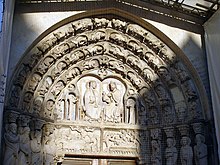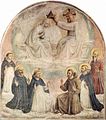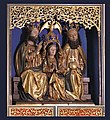Coronation of Mary

The Coronation of the Virgin , according to the presentation of the Catholic Church , the coronation of Mary , who captured his heart and soul into heaven Mother of the Lord , in heaven. Her invocation as “Queen”, “Queen of Heaven” or “Queen of the Angels” is connected with the idea of Mary's coronation. Such additions ( epithets ) have been widely used since the 12th century in the Marian hymns and prayers of the Church, but also in sermons and in theological literature.
Biblical sources
As a biblical foundation for the idea that Mary was crowned in heaven, the theologians of the Middle Ages drew verses from the Song of Songs and the Psalms, which were interpreted mariologically :
In the verse "Come with me, my bride, from Lebanon, away from Lebanon, you come with me!" ( Hld 4,8 EU ) the allegorical exegesis identifies the speaking bridegroom with Christ, who is the "sister bride" mentioned in the text. , calls to him to share in his heavenly rulership. The fact that Christ makes his mother a partner in his rulership is also derived from the verse "(...) the bride stands on your right hand in the jewelry of Ofirgold" ( Ps 45.10 EU ).
King Solomon and his mother Bathsheba were seen as typological models for the Coronation of Mary from the Old Testament . According to the first book of kings ( 1 Kings 2.19 EU ), the king seated his mother on a throne on his right hand - just like Christ, the antitypos of Solomon, put his mother on his right hand in heaven.
Modern theology sees in Mary above all the archetype of the believer. Accordingly, the idea of Mary's coronation by Christ or the Triune God is interpreted less as an exclusive statement about Mary as a person, but rather as an indication that all believers (all people) have a royal dignity before God and therefore in the world to come are allowed to live with God in “fellowship on the throne”.
The coronation of Mary is the festival content of the commemorative day of the Queen of Mary on August 22nd.
iconography
At the same time as the idea of a coronation of Mary, the coronation of Mary also became an important topic in the visual arts.
Coronation of Mary by Jesus Christ
In the High Middle Ages (around 1150–1500) the coronation of Mary is represented according to the following basic type: Mary sits (more rarely: stands or kneels) to the right of Christ and is crowned with a magnificent crown. Mary is either crowned by Christ or by angels, or she already wears the crown on her head. Often the coronation scene is accompanied by angels. Christ and Mary often appear seated together on a broad throne.
The theme found its valid formulation in the tympana of the early Gothic cathedrals in France. One of the first examples is the portal of Senlis Cathedral (around 1160/70/85). The scenes depicted under the tympanum in the lintel show the connection between the Coronation of Mary: on the left the death of Mary can be seen and on the right the elevation of her body from the grave by the angels. The Coronation of Mary, which follows above, shows the Mother of God taken up into heaven with soul and body. The iconographic theme is also known as the "Triumph of Mary". In the theological literature of the Middle Ages, Mary is also understood as an allegory of the church (Latin Ecclesia ), so that the triumph of the church is also included.

Examples of such representations are:
- Tympanum of the west portal of Senlis Cathedral (around 1160/70/85)
- Tympanum of the north transept portal of Chartres Cathedral (around 1220)
- Tympanum of the south portal at the Strasbourg Cathedral (around 1220) (Mary sits here to Christ's left)
- the tympanum on the southern choir portal of the Freiburg Cathedral (around 1360)
- the rose window in the martyrs window of the Breisach Minster (around 1280)
- Tympanum of the north portal of St-Thibault de Saint-Thibault (around the middle of the 13th century)
Coronation of Mary by the Trinity
The late Middle Ages often depict the coronation of Mary not by Christ alone, but by the Trinity . The throne on which Christ and Mary sit together then also disappears from the representation. Examples are:
- the Coronation of Mary by Hans Baldung Grien on the high altar of the Freiburg Minster (around 1520)
- the Coronation of Mary on the high altar of the Breisach Minster (around 1520)
- the Coronation of Mary by Michael Pacher on the side altar of the old parish church Gries b. Bolzano , South Tyrol (around 1470/73)
- the Maria Coronation Altar in Altenberg Cathedral (second half of the 15th century)
From the Baroque onwards, the coronation itself took a back seat, and Mary was portrayed as Queen of Heaven (Regina Coeli) or Queen of the World (Regina Mundi) .
liturgy
The coronation of Mary in heaven corresponds to the liturgical coronation of an image of Mary as the image and confession of the Church .
Picture gallery
Coronation of the Virgin Mary by Fra Angelico , approx. 1437–1446
Coronation of Mary in Altenberg Cathedral , 2nd half of the 15th century
Coronation of the Virgin , Raphael , ca.1503
Coronation of Mary , altar of the Marienkirche in Wittstock / Dosse , 1535
Coronation of the Virgin , ceiling painting in the Chiesa dell'Inviolata in Riva del Garda , approx. 1603–1636
Ceiling fresco by Giovanni Battista Tiepolo in the Church of Santa Maria della Pietà in Venice
Depiction of the Coronation of Mary above the main portal of the Carmelite Church in Mainz
Coronation of Mary with the later forbidden depiction of the Trinity as a figure with three heads and two arms (detail), Seckau basilica , bishop's chapel, Coronation altar of Mary (consecrated 1489)
Individual evidence
literature
- Coronation of Mary . In: Lexikon der Christian Ikonographie (LCI), Vol. 3. 1994. Col. 671–676.
- Wolfgang Urban : Parish church "Maria Krönung" in Stuppach . The Stuppacher Madonna. The masterpiece returns to Stuppach. (= Vernissage , vol. 20, No. 6 = No. 196). Vernissage-Verlag, Heidelberg [2012] (= Vernissage masterpieces ).








